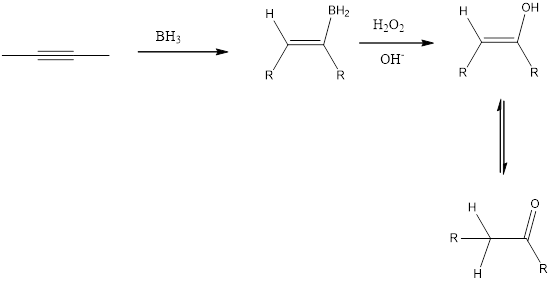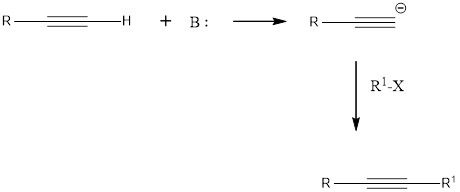
(a)
Interpretation:
The reagent that is needed to convert to ![]() each of the compound needs to be identified.
each of the compound needs to be identified.
Concept introduction:
Addition of H2O to an

(b)
Interpretation:
The reagent that is needed to ![]() convert to each of the compound needs to be identified.
convert to each of the compound needs to be identified.
Concept introduction:
Addition of 1. R2BHand 2. H2O2, OH- reagent to an alkyne is a hydroboration-oxidation reaction to form the keto product as shown below in the fig. Addition of borane forms an organoborane. Oxidation with basic H20 2 forms an enol. Tautomerization of the enol forms a carbonyl compound. The overall result is addition of H2O to a triple bond.

(c)
Interpretation:
The reagent that is needed to convert to ![]() each of the compound needs to be identified.
each of the compound needs to be identified.
Concept introduction:
Reaction between the 3-hexyne and HBr reagent is an example of electrophilic addition. The alkynes undergoes addition reaction because of pi bond in them. The electrophilic end of the reagent is attracted to the electron rich triple bond. It is a sequential reaction in which the addition of the reagent to alkyne to alkene which then addition of one more equivalent reagent to form the four new bond as

(d)
Interpretation:
The reagent that is needed to ![]() convert to each of the compound needs to be identified.
convert to each of the compound needs to be identified.
Concept introduction:
Terminal alkynes are readily converted into acetylide anions using the strong bases such as NaNH2 and NaH. These anions are strong nucleophiles, capable of reacting with electrophiles such as

Want to see the full answer?
Check out a sample textbook solution
Chapter 11 Solutions
Organic Chemistry-Package(Custom)
- Use diagram to answer the following: 1.Is the overall rxn endo- or exothermic. Explain briefly your answer____________________2. How many steps in this mechanism?_____________3. Which is the rate determining step? Explain briefly your answer____________________4. Identify (circle and label) the reactants,the products and intermediate (Is a Cation, Anion, or a Radical?) Please explain and provide full understanding.arrow_forwardDraw the entire mechanism and add Curved Arrows to show clearly how electrons areredistributed in the process. Please explain and provide steps clearly.arrow_forward15) Create Lewis structure Br Brarrow_forward
- LIOT S How would you make 200. mL of a 0.5 M solution of CuSO4 5H2O from solid copper (II) sulfate? View Rubricarrow_forwardSteps and explantions pleasearrow_forwardMatch the denticity to the ligand. Water monodentate ✓ C₂O2 bidentate H₂NCH₂NHCH2NH2 bidentate x EDTA hexadentate Question 12 Partially correct Mark 2 out of 2 Flag question Provide the required information for the coordination compound shown below: Na NC-Ag-CN] Number of ligands: 20 Coordination number: 2✔ Geometry: linear Oxidation state of transition metal ion: +3 x in 12 correct out of 2 question Provide the required information for the coordination compound shown below. Na NC-Ag-CN] Number of ligands: 20 Coordination number: 2 Geometry: linear 0 Oxidation state of transition metal ion: +3Xarrow_forward
- Can you explain step by step behind what the synthetic strategy would be?arrow_forwardPlease explain step by step in detail the reasoning behind this problem/approach/and answer. thank you!arrow_forward2. Predict the product(s) that forms and explain why it forms. Assume that any necessary catalytic acid is present. .OH HO H₂N OHarrow_forward
 Organic Chemistry: A Guided InquiryChemistryISBN:9780618974122Author:Andrei StraumanisPublisher:Cengage Learning
Organic Chemistry: A Guided InquiryChemistryISBN:9780618974122Author:Andrei StraumanisPublisher:Cengage Learning
 Organic ChemistryChemistryISBN:9781305580350Author:William H. Brown, Brent L. Iverson, Eric Anslyn, Christopher S. FootePublisher:Cengage Learning
Organic ChemistryChemistryISBN:9781305580350Author:William H. Brown, Brent L. Iverson, Eric Anslyn, Christopher S. FootePublisher:Cengage Learning


